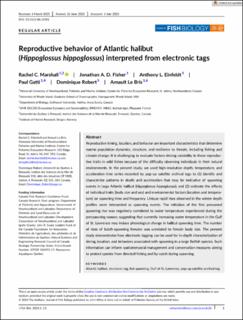| dc.description.abstract | Reproductive timing, location, and behavior are important characteristics that determine marine population dynamics, structure, and resilience to threats, including fishing and climate change. It is challenging to evaluate factors driving variability in these reproductive traits in wild fishes because of the difficulty observing individuals in their natural environments. In the present study, we used high-resolution depth, temperature, and acceleration time series recorded by pop-up satellite archival tags to (1) identify and characterize patterns in depth and acceleration that may be indicative of spawning events in large Atlantic halibut (Hippoglossus hippoglossus), and (2) estimate the effects of individual traits (body size and sex) and environmental factors (location and temperature) on spawning time and frequency. Unique rapid rises observed in the winter depth profiles were interpreted as spawning events. The initiation of the first presumed spawning rise was negatively correlated to water temperature experienced during the prespawning season, suggesting that currently increasing water temperature in the Gulf of St. Lawrence may induce phenological change in halibut spawning time. The number of rises of batch-spawning females was unrelated to female body size. The present study demonstrates how electronic tagging can be used for in-depth characterization of timing, location, and behaviors associated with spawning in a large flatfish species. Such information can inform spatiotemporal management and conservation measures aiming to protect species from directed fishing and by-catch during spawning. | |
